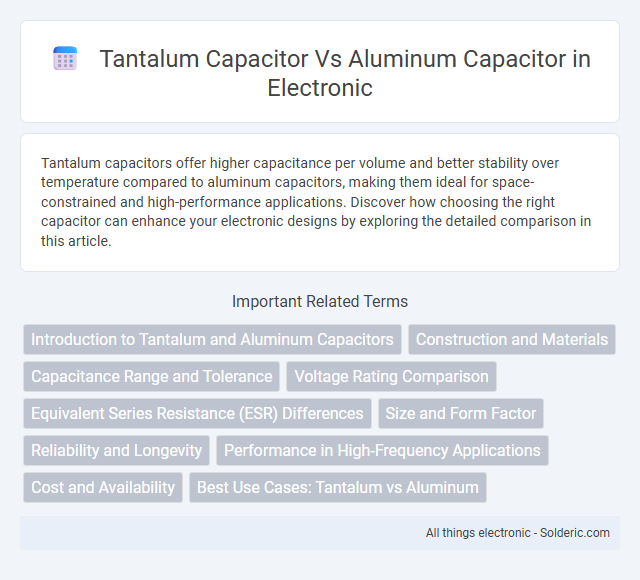Tantalum capacitors offer higher capacitance per volume and better stability over temperature compared to aluminum capacitors, making them ideal for space-constrained and high-performance applications. Discover how choosing the right capacitor can enhance your electronic designs by exploring the detailed comparison in this article.
Comparison Table
| Feature | Tantalum Capacitor | Aluminum Capacitor |
|---|---|---|
| Material | Tantalum metal anode | Aluminum foil anode |
| Capacitance Range | 0.1 uF to 1000 uF | 1 uF to 470,000 uF |
| Voltage Rating | 2V to 50V | 6.3V to 500V |
| ESR (Equivalent Series Resistance) | Low ESR, suitable for high frequency | Higher ESR compared to tantalum |
| Size & Weight | Smaller and lighter | Larger and heavier |
| Reliability | Stable, but can fail short in case of surge | Generally reliable, safer failure mode |
| Cost | Higher cost | Lower cost |
| Applications | Mobile devices, space-constrained circuits | Power supplies, audio circuits, bulk storage |
| Polarization | Polarized | Polarized |
| Temperature Range | -55degC to +125degC | -40degC to +85degC (standard) |
Introduction to Tantalum and Aluminum Capacitors
Tantalum capacitors utilize tantalum metal as the anode, offering high capacitance per volume, stable performance, and low equivalent series resistance (ESR), making them ideal for compact, high-reliability applications. Aluminum capacitors feature an aluminum foil anode with an oxide layer serving as the dielectric, known for their cost-effectiveness, large capacitance values, and suitability in general-purpose filtering and energy storage. Both capacitor types serve distinct roles in electronic circuits, with tantalum capacitors favored in precision and miniaturized designs, while aluminum capacitors excel in applications requiring higher capacitance at lower costs.
Construction and Materials
Tantalum capacitors feature a solid tantalum metal anode coated with an oxide layer acting as the dielectric, surrounded by a manganese dioxide or conductive polymer cathode, offering stable capacitance and low equivalent series resistance (ESR). Aluminum capacitors consist of an aluminum foil anode, a thin oxide layer as the dielectric, and a liquid or solid electrolyte cathode, which provides high capacitance values but typically higher ESR and larger size compared to tantalum types. Your choice between these capacitors should consider the construction impact on performance, durability, and size restrictions in your electronic designs.
Capacitance Range and Tolerance
Tantalum capacitors typically offer capacitance values ranging from 0.1 uF to around 470 uF with tight tolerance levels often within +-5%, making them ideal for precision applications. Aluminum capacitors provide a broader capacitance range, from 1 uF up to several thousand microfarads, but generally feature looser tolerances, commonly around +-20%. Selecting between these capacitors depends on your requirement for stability and accuracy in capacitance versus the need for higher capacitance values.
Voltage Rating Comparison
Tantalum capacitors typically offer higher voltage ratings ranging from 4V to 50V, making them suitable for stable low-voltage applications. Aluminum capacitors can handle a broader voltage range, often up to 450V or more, ideal for high-voltage circuits and power supply filtering. The voltage rating difference is critical when selecting capacitors for specific electronic designs requiring optimal reliability and performance under varying electrical stresses.
Equivalent Series Resistance (ESR) Differences
Tantalum capacitors typically exhibit lower Equivalent Series Resistance (ESR) compared to aluminum capacitors, enabling better performance in high-frequency applications and providing improved efficiency in power supply filtering. The lower ESR in tantalum capacitors results from their solid electrolyte construction, which reduces internal resistance and heat generation. When selecting a capacitor for circuits demanding stable ESR and minimized losses, understanding these differences helps you optimize reliability and performance.
Size and Form Factor
Tantalum capacitors offer a smaller size and more compact form factor compared to aluminum capacitors, making them ideal for applications where space is limited. Their higher volumetric efficiency allows you to achieve equivalent capacitance in a significantly reduced footprint. This compact design is beneficial for modern electronic devices requiring miniaturization without compromising performance.
Reliability and Longevity
Tantalum capacitors offer higher reliability and longer lifespan due to their stable oxide layer and low Equivalent Series Resistance (ESR), making them ideal for high-stress applications. Aluminum capacitors, while more cost-effective, generally have shorter lifespans and are prone to electrolyte evaporation and leakage, which impacts their long-term performance. Tantalum components excel in maintaining capacitance and stability under temperature variations, enhancing overall durability.
Performance in High-Frequency Applications
Tantalum capacitors offer superior performance in high-frequency applications due to their lower equivalent series resistance (ESR) and stable capacitance values under varying frequencies, making them ideal for RF circuits and signal filtering. Aluminum capacitors typically exhibit higher ESR and capacitance variation at high frequencies, which can result in less efficient filtering and potential signal degradation. Engineers often prefer tantalum capacitors when designing compact, high-frequency electronic devices requiring reliable and consistent performance.
Cost and Availability
Tantalum capacitors typically have higher costs due to expensive raw materials and complex manufacturing processes, limiting their availability compared to aluminum capacitors, which are widely produced with abundant materials. Aluminum capacitors offer a cost-effective solution with broad market accessibility, making them suitable for large-scale applications. Cost-sensitive projects often prefer aluminum capacitors for their affordability and easier sourcing, whereas tantalum capacitors are chosen for specialized, high-performance requirements despite higher expenses.
Best Use Cases: Tantalum vs Aluminum
Tantalum capacitors excel in applications requiring stable capacitance and low equivalent series resistance (ESR), making them ideal for precision circuits, power supply filtering, and space-constrained devices like smartphones and medical implants. Aluminum capacitors are better suited for high-voltage, high-capacitance applications such as power amplifiers, industrial equipment, and power factor correction due to their cost-effectiveness and robust voltage ratings. Your choice depends on the balance between size, reliability, and voltage needs in your electronic design.
Tantalum capacitor vs aluminum capacitor Infographic

 solderic.com
solderic.com